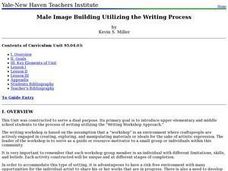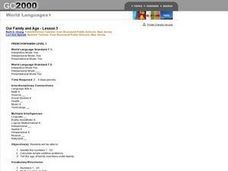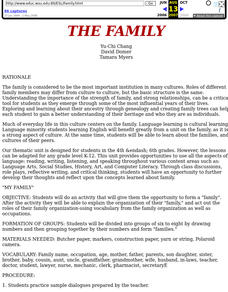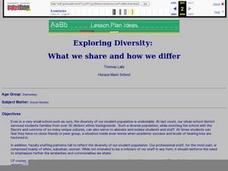Curated OER
All About Me, My Family and Friends
Students use general skills and strategies of the writing process to show their role in their family, school, friendships, the community and the world. They demonstrate their self-motivation and increasing responsibility for their own...
Nancy Fetzer's Literacy Connections
Expository Paragraph
Upper elementary and middle school writers learn how to craft an expository paragraph by following the six steps detailed in a 48-page instructional guide. Learners learn how to write six different types of informational paragraphs: to...
Curated OER
Male Image Building Utilizing the Writing Process
Introduce your class to the techniques of proper writing. In groups, they brainstorm their ideas on family structures and discuss the importance of having a male figure in their lives. After listening to an African-American poem, they...
Virginia Department of Education
Atomic Structure: Periodic Table
The fifth lesson of seven in the series outlines an in-depth analysis of the periodic table. After direct instruction, pupils take turns practicing in the group before beginning independent study. The assessments include a quiz and an...
Curated OER
Reading for Information
What should readers do to prepare for reading an informational text? What should they do during their reading? What should they do after completing such a text? Introduce your pupils to reading strategies and techniques to gain meaning...
Museum of Tolerance
Immigration Journeys
Through the journey of four stories of immigration, scholars complete graphic organizers and apply knowledge to create a visual representation of their findings on a large poster. Third and fourth readers write a letter to their family...
Starry Night Education
The Stars
Three astronomy activities in one resource! Here you will find one hands-on activity, one demonstration, both with discussion questions, and one activity worksheet. During these lessons young scientists discuss how stars are different,...
Missouri Department of Elementary
Celebrate Your Culture
After a class discussion about celebrations and customs, class members draw pictures depicting special events from their family cultures. Next, they draw pictures of an event from a different culture and share their work with classmates.
Curated OER
Our Family and Age
Start by playing a song about numbers. "Sing, Dance, Laugh, and Eat Quiche" is suggested. Then, start counting things around the room. Introduce yourself, and have kids start to introduce themselves when they catch on to the vocabulary....
Curated OER
What Does Respect Look Like at Home?
Fourth graders conceptualize the value of respect for self, and give examples and non-examples. They describe how things could have been done differently within the family or the community for non-examples. Students conceptualize the...
Curated OER
The Family
Students investigate family organization and create a family unit. They decide the relationships, make ID's, and makes a family tree. They introduce their family units to the others in the class while the teacher takes family pictures....
Curated OER
Relationships, Day 3: Families
Students examine roles of family members and why families are important. They view magazine pictures and define family, describe their own families, draw a picture or diagram of their family, and pair pictures of family members to their...
Curated OER
What Structures and Behaviours Can Be Observed in Vinegar Eels?
Students view vinegar eels under a microscope at different magnifications. They use a DigiScope with the camera attachment in place of the eyepiece. Students count the number of thrashing movements in 10 seconds. They repeat this three...
Curated OER
Friday and Friends: A Prospectus of the Mexican Family through Children's Literature
Young scholars use literature to examine how the structure of families in Mexico has changed over time. In groups, they examine how their life now relates to their ancestors and the Spanish conquest of the area. As a class, they are...
Curated OER
Description Of Family
Students describe four people in their family. They create a visual organizer to introduce their family members. Using a multimedia presentation, students introduce their family to others. A rubric is used to evaluate each presentation.
Curated OER
Levels of Classification
Young scholars use diagrams to compare structural differences that taxonomists use to classify animals. For this classification lesson plan, students compare structures of different species from given diagrams. In one diagram they...
Curated OER
Shoes from Grandpa Lesson Plan
Students read a cumulative text. In this Shoes from Grandpa lesson plan, students examine language usage, different media sources, and literary devices.
Curated OER
Who's In The Fact Family?
Students study related addition and subtraction facts. For this math lesson, students use related addition and subtraction to solve problems. Students use manipulatives to explore fact families.
Curated OER
Exploring Diversity: What We Share and How We Differ
Young scholars discuss the amount of diversity at their school. They examine a culture other than their own and share it with their classmates. They discuss the importance of diversity to end the lesson.
California Academy of Science
How Big is Big?
In a math or life science class, "mini-me" models are created with cardstock to reflect a 1:10 scale of students' bodies. Learners measure each others' heights with meter sticks, and then reduce the size by 10. After this exercise, they...
Virginia Department of Education
Elements and Electron Configuration
It's electronic! Pupils uncover elements and their electron configurations as they explore mass, groupings, correct charges, and sliding theory. Young scientists learn creative ways to remember various elements and correctly classify...
AAAS
Identification and Classification of Grassland Plants
Take learning outside and start classifying grasslands. Young ecologists observe grassland plants in order to classify them into the appropriate species by family. They note their characteristics and where they grow. A true field...
Hawaiʻi State Department of Education
Color Moods
Can art be a mode of communication? You bet it can! Learners explore how colors are used to convey mood in art. First, the class listens to three very unique musical selections that convey three different moods. Then, they compare and...
Curated OER
Homes of the World: Ceramic Lesson
Kids consider the various dwellings humans inhabit all over the world. They choose a home from anywhere in the world. Then they research the type of materials, designs, and structures need to build that type of home. The project ends...

























